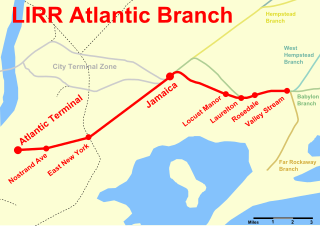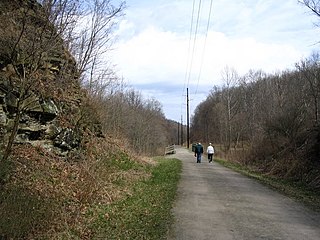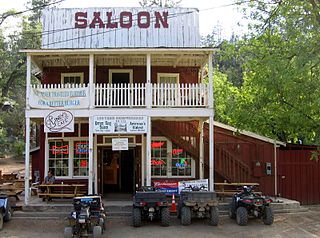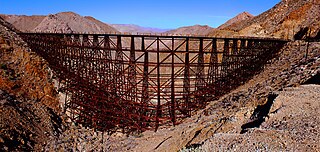
The First Transcontinental Railroad was a 1,912-mile (3,077 km) continuous railroad line constructed between 1863 and 1869 that connected the existing eastern U.S. rail network at Council Bluffs, Iowa with the Pacific coast at the Oakland Long Wharf on San Francisco Bay. The rail line was built by three private companies over public lands provided by extensive US land grants. Construction was financed by both state and US government subsidy bonds as well as by company issued mortgage bonds. The Western Pacific Railroad Company built 132 mi (212 km) of track from the road's western terminus at Alameda/Oakland to Sacramento, California. The Central Pacific Railroad Company of California (CPRR) constructed 690 mi (1,110 km) eastward from Sacramento to Promontory Summit, Utah Territory. The Union Pacific Railroad (UPRR) built 1,085 mi (1,746 km) from the road's eastern terminus at the Missouri River settlements of Council Bluffs and Omaha, Nebraska westward to Promontory Summit.

The Kettle Valley Railway was a subsidiary of the Canadian Pacific Railway (CPD) that operated across southern British Columbia, west of Midway running to Rock Creek, then north to Myra Canyon, down to Penticton over to Princeton, Coalmont, Brookmere, Coquihalla and finally Hope where it connected to the main CPR line.

The Cincinnati, Lebanon and Northern Railway (CL&N) was a local passenger and freight-carrying railroad in the southwestern part of the U.S. state of Ohio, connecting Cincinnati to Dayton via Lebanon. It was built in the late 19th century to give the town of Lebanon and Warren County better transportation facilities. The railroad was locally known as the "Highland Route", since it followed the ridge between the Little and Great Miami rivers, and was the only line not affected by floods such as the Great Dayton Flood of 1913.

The Virginia and Truckee Railroad is a privately owned historical heritage railroad, headquartered in Virginia City, Nevada. Its private and publicly owned route is 14 miles long. The railroad owns and uses the service mark "Queen of the Short Lines". The V&T Railroad runs up to seven trains per day, many in steam behind locomotive #29, a 2-8-0 Consolidation, or an ex-US Army GE 80-ton diesel from Virginia City, from Memorial Day until the end of October each year.

The San Diego and Arizona Railway was a 148-mile (238 km) short line U.S. railroad founded by entrepreneur John D. Spreckels, and dubbed "The Impossible Railroad" by engineers of its day due to the immense logistical challenges involved. It linked San Diego, its western terminus, with El Centro, its eastern terminus, where passengers could connect with Southern Pacific's transcontinental lines, eliminating the need to first travel north via Los Angeles or Riverside.

The Atlantic Branch is an electrified rail line owned and operated by the Long Island Rail Road in the U.S. state of New York. It is the only LIRR line that runs in the borough of Brooklyn.

The Montour Trail is a multi-use recreational rail trail near Pittsburgh, Pennsylvania. It was formerly the Montour Railroad.

The Capital Crescent Trail (CCT) is a 7.04-mile (11.33 km) long, shared-use rail trail that runs from Georgetown in Washington, D.C., to Bethesda, Maryland. An extension of the trail from Bethesda to Silver Spring, along a route formerly known as the Georgetown Branch Trail is currently being constructed as part of the Purple Line light rail project.

The Sacramento Northern Railway was a 183-mile (295 km) electric interurban railway that connected Chico in northern California with Oakland via the California capital, Sacramento. In its operation it ran directly on the streets of Oakland, Sacramento, Yuba City, Chico, and Woodland and ran interurban passenger service until 1941 and freight service into the 1960s.
The Bradshaw Mountain Railroad was a subsidiary of the Santa Fe, Prescott and Phoenix Railway (SFP&P) in Arizona. The 35.65-mile (57.37 km) railroad was built to serve the mines in the Bradshaw Mountains. The railroad built from a connection at Poland Junction and at Mayer with the Prescott and Eastern Railroad. The Prescott & Eastern was also operated by the SFP&P.

The Metropolitan Subdivision is a railroad line owned and operated by CSX Transportation in the District of Columbia and the U.S. state of Maryland. The line runs from Washington, D.C., northwest to Weverton, Maryland, along the former Metropolitan Branch of the Baltimore and Ohio Railroad.

Crown King is an unincorporated community in Yavapai County, Arizona, United States, located at an elevation of 5,771 feet (1,759 m). Crown King has a ZIP Code of 86343; in 2000, the population of the 86343 ZCTA was 133. The site of a former gold mining town, Crown King is 28 miles west of Interstate 17 on Senator Highway, high in the Bradshaw Mountains. The community is named after the Crowned King mine, but the name was shortened to Crown King in 1888. Horsethief Basin Lake resides 6.5 miles southeast of Crown King on Crown King Rd/Forest 259 Rd.
The Woodinville Subdivision is a railroad line that was formerly owned by BNSF Railway. It takes its name from one of its original end points in Woodinville, Washington, United States. The line extends approximately 42 miles (68 km) in east King County and Snohomish County. The line's ownership has been transferred in a deal involving King County and the Port of Seattle. The section from Snohomish to Woodinville is operated, on contract, by a company called Eastside Rail Freight, which is associated with the Ballard Terminal Railroad and Meeker Southern. However, train traffic on the subdivision is exceedingly rare, with the Seattle region's rail operations now conducted on other higher capacity routes.

The Northern Transcon, a route operated by the BNSF Railway, traverses the most northerly route of any railroad in the western United States. This route was originally part of the Chicago, Burlington and Quincy Railroad, Northern Pacific Railway, Great Northern Railway and Spokane, Portland and Seattle Railway systems, merged into the Burlington Northern Railroad system in 1970.

Clemenceau is a neighborhood of the city of Cottonwood in Yavapai County, Arizona, United States. It was built as a company town in 1917 to serve the new smelter for James Douglas, Jr.'s United Verde Extension Mine (UVX) in Jerome. The town was originally named Verde after the mine, but it was changed to Clemenceau in 1920 in honor of the French premier in World War I, Georges Clemenceau, a personal friend of Douglas. Clemenceau would later leave a vase designed by the French potter Ernest Chaplet to the town in return.

The Peninsula Extension which created the Peninsula Subdivision of the Chesapeake and Ohio Railway (C&O) was the new railroad line on the Virginia Peninsula from Richmond to southeastern Warwick County. Its principal purpose was to provide an important new pathway for coal mined in West Virginia to reach the harbor of Hampton Roads for coastal and export shipping on collier ships.
Central Railroad of Long Island was built on Long Island, New York, by Alexander Turney Stewart, who was also the founder of Garden City. The railroad was established in 1871, then merged with the Flushing and North Side Railroad in 1874 to form the Flushing, North Shore and Central Railroad. It was finally acquired by the Long Island Rail Road in 1876 and divided into separate branches. Despite its short existence, the CRRLI had a major impact on railroading and development on Long Island.
Bellingham Bay and British Columbia Railroad was built in the northwestern part of Washington, between the town of Whatcom, now Bellingham, then to the town of Sumas, to connect with the Canadian Pacific Railway for a continental connection.

The Adobe Mountain Desert Park a.k.a. "The Railroad Park" is a park complex which houses the Sahuaro Central Railroad Heritage preservation Society, the Sahuroa Central Railroad Museum, the Arizona Model Railroading Society and the Maricopa Live Steamers. The approximately 160-acre Adobe Mountain Desert Railroad Park is located south of Pinnacle Peak Road on 43rd Avenue in the City of Glendale, Arizona.

Goat Canyon Trestle is a wooden trestle in San Diego County, California. At a length of 597–750 feet (182–229 m), it is the world's largest all-wood trestle. Goat Canyon Trestle was built in 1933 as part of the San Diego and Arizona Eastern Railway, after one of the many tunnels through the Carrizo Gorge collapsed. The railway had been called the "impossible railroad" upon its 1919 completion. It ran through Baja California and eastern San Diego County before ending in Imperial Valley. The trestle was made of wood, rather than metal, due to temperature fluctuations in the Carrizo Gorge. By 2008, rail traffic stopped using the trestle.















